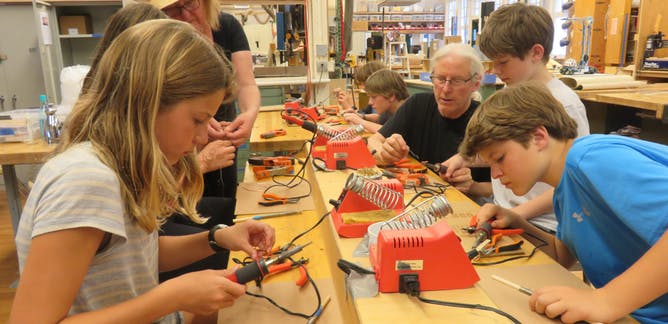Industrial Education Ch. 2: Early Years
This series of posts discusses the current state of industrial education in the US and around the world. I will cover topics covering elementary through high school education (including the STEM programs), vocational/technical schools and colleges, independent for profit courses both online and in-person, and some of the resources that can be found on the internet.
********************************************************

Preparing people for the workforce starts at a very young age. Before starting school at age 5 or 6 years old children absorb information at a rapid rate, developing basic skills from parents and pre-school programs. Often children can read and know how to behave long before starting school. Unfortunately, not every child has the same opportunity to develop skills before reaching school age, whether because of lack of parental involvement or lack of resources.
Teachers in elementary education are required to take classes in child psychology, curriculum development, science, English, mathematics and technology. They also usually have to intern at a school, learning techniques from other teachers.
While there are national standards for education, curriculum requirements in the US are often administered at a state and local level. Resources and funding are also a mixture of national, state and local. This creates a large difference in quality depending on where a child lives and goes to school. Everything is affected, from teacher salaries to the facilities to the books and raw materials.
A relatively recent development in education is the focus on STEM (Science, Technology, Engineering and Math). After World War II there was a push to get back to the fundamentals of education, “reading, ‘riting and ‘rithmetic”. Much of this involved rote memorization and drills. In the 1970s education evolved into a more individualized and equality based system. As technology evolved in the 1990s and 2000s, an instructional shift took place in the US towards STEM. With recognition that creative thinking was also required, a call to include the Arts was added, hence the modified acronym “STEAM”, (Science, Technology, Engineering Arts and Math).
This approach advocates that education moves away from compartmentalizing subjects and emphasizes skills acquisition, collaboration, problem solving, and critical thinking. Some schools however has taken this to mean that rigorous science and math classes should be taught to everyone regardless of interest, leading to student disengagement. Much of the evolution from STEM to STEAM was in response to marginalizing arts programs due to extra funding of science and technology programs, which often require technology products and teaching aids.

Last week I interviewed Beatriz Rodriquez, who founded Braingineers Lab, a “Makerspace” that has afterschool programs involving STEM/STEAM projects and workshops. She has also worked in the presecondary school system and had some good feedback on the current state of elementary through high school education.
She said that children were learning to read and write early and that there was an emphasis on learning these skills in Kindergarten and even preschool, but she would sometimes have students that didn’t yet have the hand skills to use a pair of scissors. Because of the easy availability of entertainment like television and video games, kids often didn’t have much creativity. They also sometimes hadn’t needed to persevere much and make things work. Programs at Braingineers Lab allow children to explore and learn new skills.
Makerspaces allow adults with shared interests, especially in computing, technology or specialized crafting, gather to work on projects while sharing ideas, tools and knowledge. Braingineers provides a place for children to do this on a workshop or afterschool basis, also providing activities for homeschoolers. Learning through STEAM based techniques helps promote creativity, innovation, higher order thinking, and problem-solving skills.
She also mentioned that there were some good programs at some of the elementary and middle schools in the area, providing resources for robotics and CAD, 3D printing and other technology programs, but that it was not consistent across all schools. Braingineers provides a place for programs like this. She also plans to add a sound studio soon.
Programs like this are more expensive than typical paid afterschool activities like gymnastics, dance and martial arts due to the cost of some of the technology and materials, but they provide skills that can be used in the workplace when kids get older. Skills like soldering and wiring of electrical circuits, CAD and 3D modeling and programming software are directly transferrable to later work skills.
**********************************
One thing I have noticed while researching these educational topics: schools don’t seem to have a problem spending money on technology and hardware for training, but teachers and instructors are typically not paid very well compared to other professions. This is true in public and private schools, junior colleges and vocational schools, and even in colleges and universities with the exception of tenured professors. Even then, considering that they have spent ten years or more in post-secondary education, they may make more in the private sector. If an engineer wanted to teach in high school or junior college they would need to take a serious pay cut. I don’t have a solution to this problem, but it seems that there is a lot of administrative overhead. The US spends more per student than most other developed countries, but the test results don’t seem to match the resources expended.
Please let me know your thoughts on this subject. Next up: High school and more on STEM/STEAM programs!
